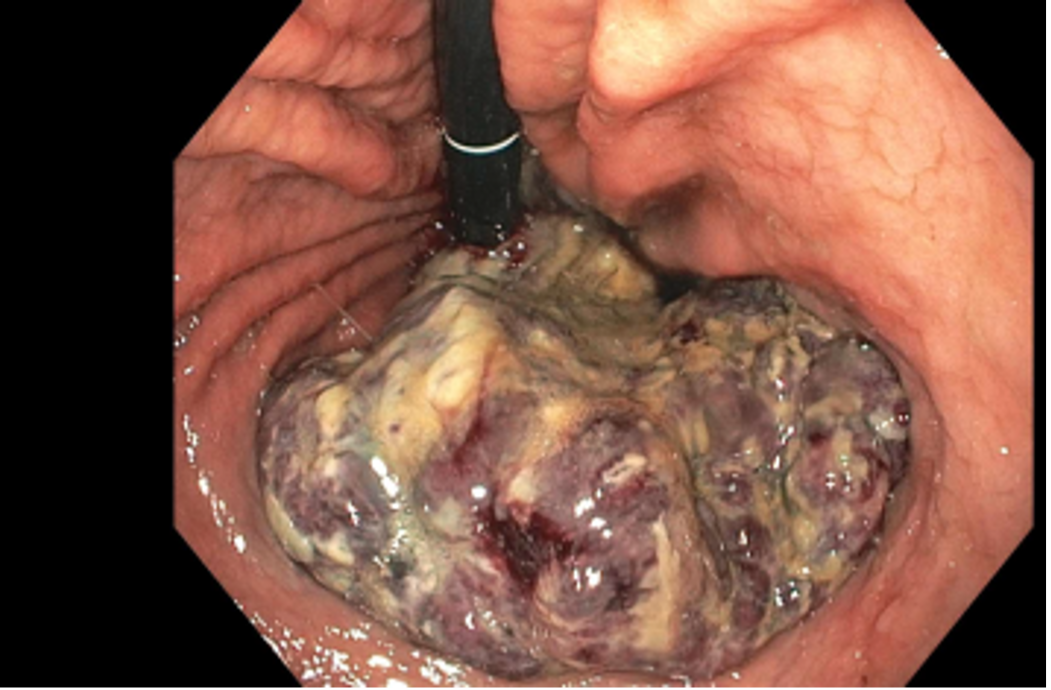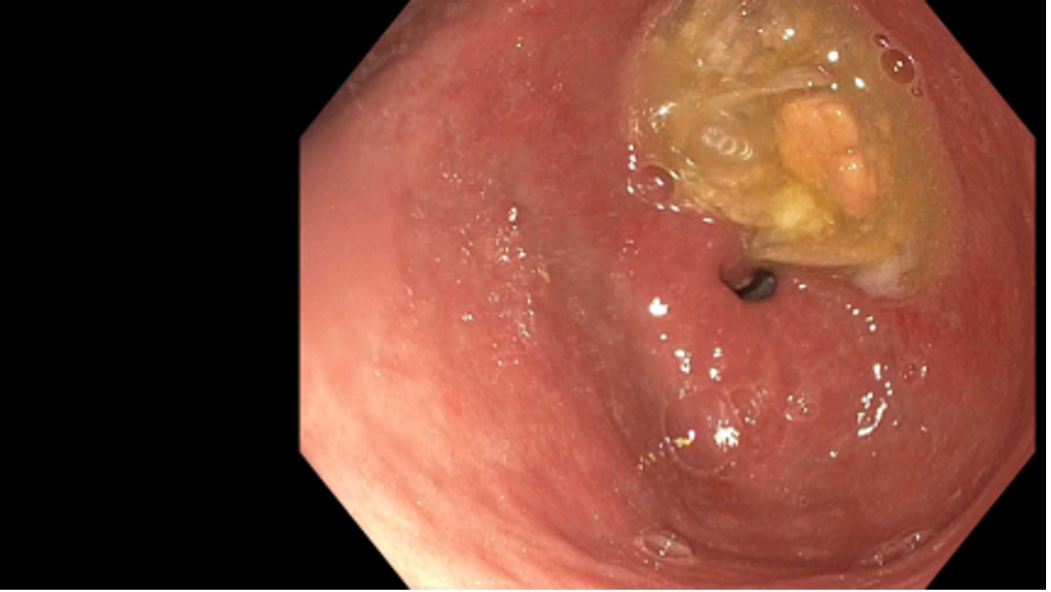Sunday Poster Session
Category: Stomach and Spleen
P2135 - Gastric Small Cell Carcinoma Presenting as a Fungating Mass in the Gastric Cardia: A Rare Case Report
Sunday, October 26, 2025
3:30 PM - 7:00 PM PDT
Location: Exhibit Hall
- MK
Musa Khalil, MD (he/him/his)
Howard University Hospital
Washington, DC
Presenting Author(s)
Ali Chand, MD, Musa Khalil, MD, Pinky Bai, MD, Muhammad Hassan, MD, Angesom Kibreab, MD, Mukarram Jamat Ali, MD
Howard University Hospital, Washington, DC
Introduction: Gastric small cell carcinoma (GSCC) is an exceedingly rare and aggressive neuroendocrine malignancy. It constitutes less than 0.1% of gastric cancers. GSCC, mostly presenting as an ulcerative lesion, is typically seen in Japanese in their 70s. Here, we report an unusual case of fungating GSCC lesion in an African American patient in his 60s. It emphasizes the need for vigilance in diagnosing atypical gastric cancers.
Case Description/
Methods: A 63-year-old African American male with a history of prostate adenocarcinoma (status post-prostatectomy) and a 30-pack-year history of smoking presented with heartburn and dyspepsia, which were attributed to gastroesophageal reflux disease (GERD). Initial esophagogastroduodenoscopy (EGD) revealed only erythematous gastric mucosa. H. pylori was negative. Proton pump inhibitors were prescribed which improved symptoms. However, two years later, patient was evaluated for similar symptoms and a repeat EGD was done which again showed erythematous gastric mucosa with negative H. pylori, and an increased dose of PPIs was recommended. Three years later, patient presented to the hospital with fatigue and severe anemia (hemoglobin 4.7 mg/dL). A repeat EGD revealed a fungating mass in the gastric cardia. Biopsy confirmed primary GSCC, with immunohistochemistry positive for CK8/18, TTF-1, synaptophysin, and focal chromogranin staining. Imaging excluded metastasis. The patient was started on carboplatin and etoposide-based chemotherapy.
Discussion: GSCC is known for its aggressive progression and poor prognosis, with early lymphatic spread being common. Most of the cases present as ulcerative lesions while the fungating manifestation is extremely rare. A review of nine GSCC cases highlighted epigastric pain and anemia as frequent presentations. Histopathology consistently shows neuroendocrine markers, with chemotherapy, often platinum-based, being the mainstay of treatment. Our case is unique in its rapid progression from benign-appearing gastritis to carcinoma within a short time frame. Furthermore, it is the first reported case of fungating GSCC in an African-American patient. There is a need of future studies to characterize the appropriate follow up interval in such cases for early diagnosis and prompt treatment.

Figure: Gastritis in gastric pylorus with food residue

Figure: Fungating mass in gastric cardia
Disclosures:
Ali Chand indicated no relevant financial relationships.
Musa Khalil indicated no relevant financial relationships.
Pinky Bai indicated no relevant financial relationships.
Muhammad Hassan indicated no relevant financial relationships.
Angesom Kibreab indicated no relevant financial relationships.
Mukarram Jamat Ali indicated no relevant financial relationships.
Ali Chand, MD, Musa Khalil, MD, Pinky Bai, MD, Muhammad Hassan, MD, Angesom Kibreab, MD, Mukarram Jamat Ali, MD. P2135 - Gastric Small Cell Carcinoma Presenting as a Fungating Mass in the Gastric Cardia: A Rare Case Report, ACG 2025 Annual Scientific Meeting Abstracts. Phoenix, AZ: American College of Gastroenterology.
Howard University Hospital, Washington, DC
Introduction: Gastric small cell carcinoma (GSCC) is an exceedingly rare and aggressive neuroendocrine malignancy. It constitutes less than 0.1% of gastric cancers. GSCC, mostly presenting as an ulcerative lesion, is typically seen in Japanese in their 70s. Here, we report an unusual case of fungating GSCC lesion in an African American patient in his 60s. It emphasizes the need for vigilance in diagnosing atypical gastric cancers.
Case Description/
Methods: A 63-year-old African American male with a history of prostate adenocarcinoma (status post-prostatectomy) and a 30-pack-year history of smoking presented with heartburn and dyspepsia, which were attributed to gastroesophageal reflux disease (GERD). Initial esophagogastroduodenoscopy (EGD) revealed only erythematous gastric mucosa. H. pylori was negative. Proton pump inhibitors were prescribed which improved symptoms. However, two years later, patient was evaluated for similar symptoms and a repeat EGD was done which again showed erythematous gastric mucosa with negative H. pylori, and an increased dose of PPIs was recommended. Three years later, patient presented to the hospital with fatigue and severe anemia (hemoglobin 4.7 mg/dL). A repeat EGD revealed a fungating mass in the gastric cardia. Biopsy confirmed primary GSCC, with immunohistochemistry positive for CK8/18, TTF-1, synaptophysin, and focal chromogranin staining. Imaging excluded metastasis. The patient was started on carboplatin and etoposide-based chemotherapy.
Discussion: GSCC is known for its aggressive progression and poor prognosis, with early lymphatic spread being common. Most of the cases present as ulcerative lesions while the fungating manifestation is extremely rare. A review of nine GSCC cases highlighted epigastric pain and anemia as frequent presentations. Histopathology consistently shows neuroendocrine markers, with chemotherapy, often platinum-based, being the mainstay of treatment. Our case is unique in its rapid progression from benign-appearing gastritis to carcinoma within a short time frame. Furthermore, it is the first reported case of fungating GSCC in an African-American patient. There is a need of future studies to characterize the appropriate follow up interval in such cases for early diagnosis and prompt treatment.

Figure: Gastritis in gastric pylorus with food residue

Figure: Fungating mass in gastric cardia
Disclosures:
Ali Chand indicated no relevant financial relationships.
Musa Khalil indicated no relevant financial relationships.
Pinky Bai indicated no relevant financial relationships.
Muhammad Hassan indicated no relevant financial relationships.
Angesom Kibreab indicated no relevant financial relationships.
Mukarram Jamat Ali indicated no relevant financial relationships.
Ali Chand, MD, Musa Khalil, MD, Pinky Bai, MD, Muhammad Hassan, MD, Angesom Kibreab, MD, Mukarram Jamat Ali, MD. P2135 - Gastric Small Cell Carcinoma Presenting as a Fungating Mass in the Gastric Cardia: A Rare Case Report, ACG 2025 Annual Scientific Meeting Abstracts. Phoenix, AZ: American College of Gastroenterology.
